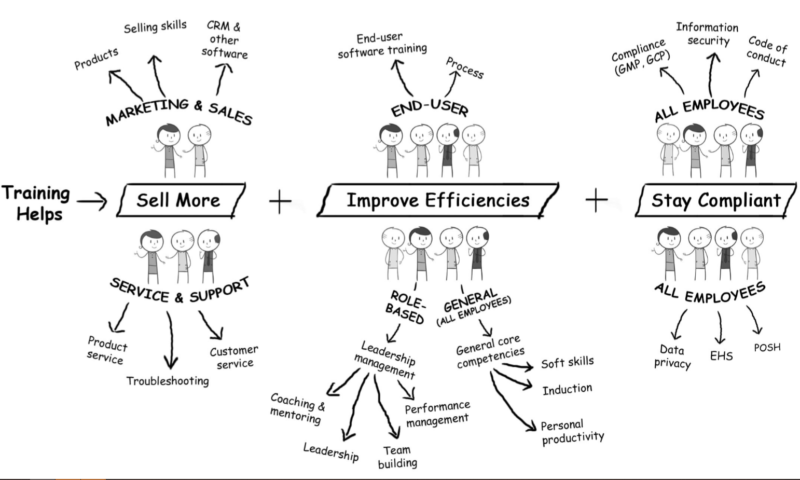Seeing The Big Picture
Not everyone understands that training is a big part of achieving business goals. Some organizations aren't always very clear on exactly how training helps achieve their business goals. This analysis aims to help Learning and Development professionals realize that organizations need effective training in order to reach their objectives.

As Instructional Designers, and maybe even as training managers, we sometimes tend to be a bit removed from the larger business context. However, it is this big picture that should actually determine our direction and drive our training effort. To begin with, we need to have a sound understanding of where training fits in the overall scheme of things in the business context. What does it do? And how?
To put it very simply, for any business to meet its typical business goals, it has to:
- Sell more
- Improve efficiencies
- Stay compliant

Training is an ongoing process that helps companies achieve their goals. It helps your teams sell more by educating them about your products and services, improving their selling skills, and making them more effective in troubleshooting and customer support. It can improve the efficiency of every department with various forms of training while building general core competencies. Finally, it ensures compliance, as it is the only way that your employees can familiarize themselves with the latest standards and codes of conduct.
At the risk of stating the obvious, without training, it is impossible for any organization to achieve its goals. And yet, if we are to take a hard and honest look at our own training effort, we can see where and why we were involved in rolling out training that actually didn’t help achieve any of these goals.
The many programs/courses that are sometimes rolled out without any tangible goals are the main reason many stakeholders and learners sometimes view the training function with suspicion. We can change all that by being fully aware of the big picture and ensuring what we do fits right into it.
But How Can Training Help Achieve Business Goals?
1. Aligning Learning Objectives To Business Goals

Desired Organizational
|
Desired
|
Performance-Based
|
2. Have A Blended Solution
If our mission is to accelerate proficiency, we should create a blend that will enable learners to achieve the required level of performance (proficiency) as efficiently as possible.
In particular, we want to make sure our blends:
- Leverage the best of both approaches to maximize the benefits for each situation
- Streamline the time and cost required to reach proficiency
- Facilitate access to learning when it is needed, where it is needed, and Just-In-Time
- Appeal to and address different learning modalities
- Make learning a guided process, not a one-time event
3. Develop eLearning Curriculums
| For The Learner | For The SME | For Your Organization |
|
|
|
Instructional Designers are an understated lot. Most of us, although we’ve been around eLearning for 10 years or more, we have no formal degree in eLearning and yet we have jobs that require us to churn out world-class, highly effective eLearning courses for which the target audience is people from every background on the planet. So how did we land up here anyway, given that we come from diverse functional backgrounds?
Most likely, we were good at our job—the one we got academic degrees for—and because we were so good at it, we were asked to train others. And before we knew it, we were full-time training professionals. With technology becoming a game-changer and the advent of eLearning, this training function has now extended to creating training material for online training or eLearning. We learned the ropes in record time and transferred those skills into Instructional Design for eLearning. The eBook "Rapid eLearning Design For Quick Rollout" contains the most valuable methods and strategies we use in order to be fast and efficient.

